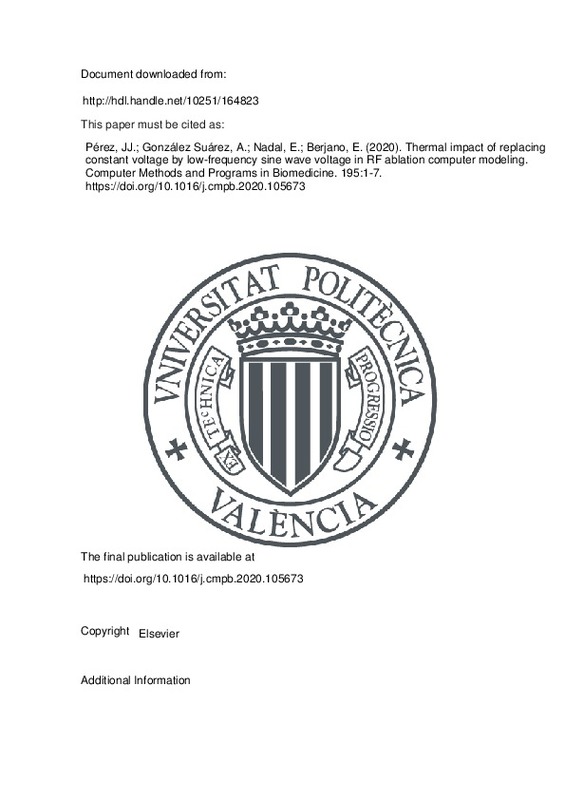Doss, J. D. (1982). Calculation of electric fields in conductive media. Medical Physics, 9(4), 566-573. doi:10.1118/1.595107
Tungjitkusolmun, S., Haemmerich, D., Hong Cao, Jang-Zern Tsai, Young Bin Choy, Vorperian, V. R., & Webster, J. G. (2002). Modeling bipolar phase-shifted multielectrode catheter ablation. IEEE Transactions on Biomedical Engineering, 49(1), 10-17. doi:10.1109/10.972835
Yan, S., Wu, X., & Wang, W. (2016). A simulation study to compare the phase-shift angle radiofrequency ablation mode with bipolar and unipolar modes in creating linear lesions for atrial fibrillation ablation. International Journal of Hyperthermia, 32(3), 231-238. doi:10.3109/02656736.2016.1145746
[+]
Doss, J. D. (1982). Calculation of electric fields in conductive media. Medical Physics, 9(4), 566-573. doi:10.1118/1.595107
Tungjitkusolmun, S., Haemmerich, D., Hong Cao, Jang-Zern Tsai, Young Bin Choy, Vorperian, V. R., & Webster, J. G. (2002). Modeling bipolar phase-shifted multielectrode catheter ablation. IEEE Transactions on Biomedical Engineering, 49(1), 10-17. doi:10.1109/10.972835
Yan, S., Wu, X., & Wang, W. (2016). A simulation study to compare the phase-shift angle radiofrequency ablation mode with bipolar and unipolar modes in creating linear lesions for atrial fibrillation ablation. International Journal of Hyperthermia, 32(3), 231-238. doi:10.3109/02656736.2016.1145746
Pérez, J. J., González-Suárez, A., & Berjano, E. (2017). Numerical analysis of thermal impact of intramyocardial capillary blood flow during radiofrequency cardiac ablation. International Journal of Hyperthermia, 34(3), 243-249. doi:10.1080/02656736.2017.1336258
Keangin, P., Wessapan, T., & Rattanadecho, P. (2011). Analysis of heat transfer in deformed liver cancer modeling treated using a microwave coaxial antenna. Applied Thermal Engineering, 31(16), 3243-3254. doi:10.1016/j.applthermaleng.2011.06.005
Nakayama, A., & Kuwahara, F. (2008). A general bioheat transfer model based on the theory of porous media. International Journal of Heat and Mass Transfer, 51(11-12), 3190-3199. doi:10.1016/j.ijheatmasstransfer.2007.05.030
Bhowmik, A., Singh, R., Repaka, R., & Mishra, S. C. (2013). Conventional and newly developed bioheat transport models in vascularized tissues: A review. Journal of Thermal Biology, 38(3), 107-125. doi:10.1016/j.jtherbio.2012.12.003
Andreozzi, A., Brunese, L., Iasiello, M., Tucci, C., & Vanoli, G. P. (2018). Modeling Heat Transfer in Tumors: A Review of Thermal Therapies. Annals of Biomedical Engineering, 47(3), 676-693. doi:10.1007/s10439-018-02177-x
Iasiello M., Andreozzi A., Bianco N., Vafai K. The porous media theory applied to radiofrequency catheter ablation. Int. J. Numer. Methods Heat Fluid Flow, Vol. 30 No. 5, pp. 2669–2681. 10.1108/HFF-11-2018-0707.
González‐Suárez, A., Herranz, D., Berjano, E., Rubio‐Guivernau, J. L., & Margallo‐Balbás, E. (2017). Relation between denaturation time measured by optical coherence reflectometry and thermal lesion depth during radiofrequency cardiac ablation: Feasibility numerical study. Lasers in Surgery and Medicine, 50(3), 222-229. doi:10.1002/lsm.22771
Irastorza, R. M., Gonzalez-Suarez, A., Pérez, J. J., & Berjano, E. (2020). Differences in applied electrical power between full thorax models and limited-domain models for RF cardiac ablation. International Journal of Hyperthermia, 37(1), 677-687. doi:10.1080/02656736.2020.1777330
Seiler, J., Roberts-Thomson, K. C., Raymond, J.-M., Vest, J., Delacretaz, E., & Stevenson, W. G. (2008). Steam pops during irrigated radiofrequency ablation: Feasibility of impedance monitoring for prevention. Heart Rhythm, 5(10), 1411-1416. doi:10.1016/j.hrthm.2008.07.011
González-Suárez, A., Berjano, E., Guerra, J. M., & Gerardo-Giorda, L. (2016). Computational Modeling of Open-Irrigated Electrodes for Radiofrequency Cardiac Ablation Including Blood Motion-Saline Flow Interaction. PLOS ONE, 11(3), e0150356. doi:10.1371/journal.pone.0150356
Bourier, F., Duchateau, J., Vlachos, K., Lam, A., Martin, C. A., Takigawa, M., … Jais, P. (2018). High‐power short‐duration versus standard radiofrequency ablation: Insights on lesion metrics. Journal of Cardiovascular Electrophysiology, 29(11), 1570-1575. doi:10.1111/jce.13724
Labonte, S. (1994). Numerical model for radio-frequency ablation of the endocardium and its experimental validation. IEEE Transactions on Biomedical Engineering, 41(2), 108-115. doi:10.1109/10.284921
Babuska, I., & Oden, J. T. (2004). Verification and validation in computational engineering and science: basic concepts. Computer Methods in Applied Mechanics and Engineering, 193(36-38), 4057-4066. doi:10.1016/j.cma.2004.03.002
[-]







![[Cerrado]](/themes/UPV/images/candado.png)


